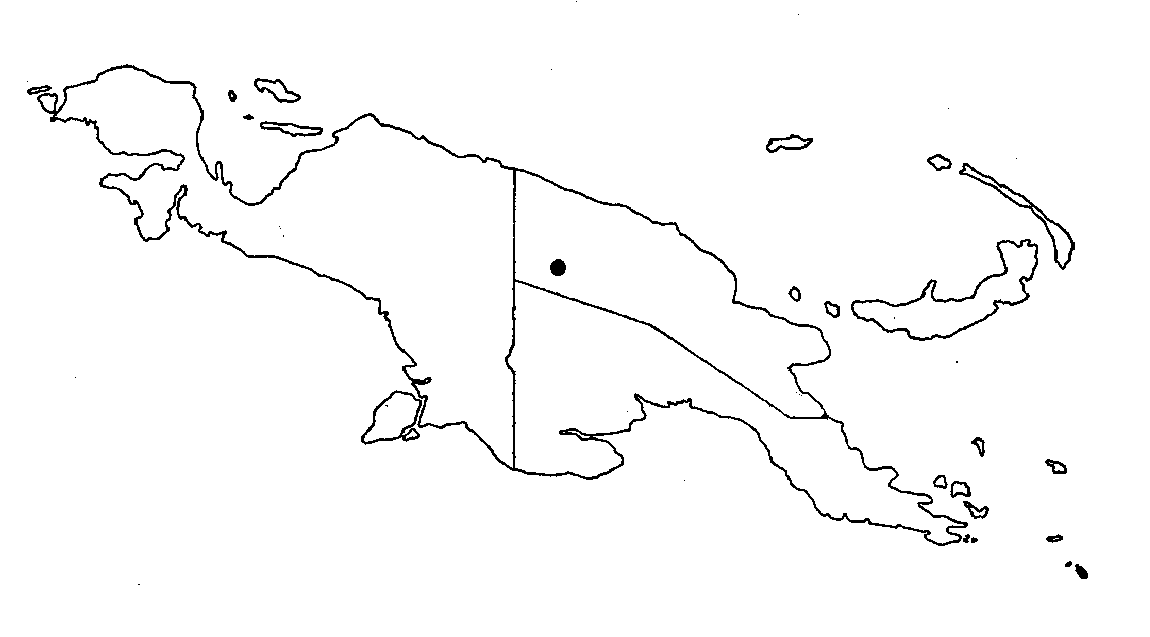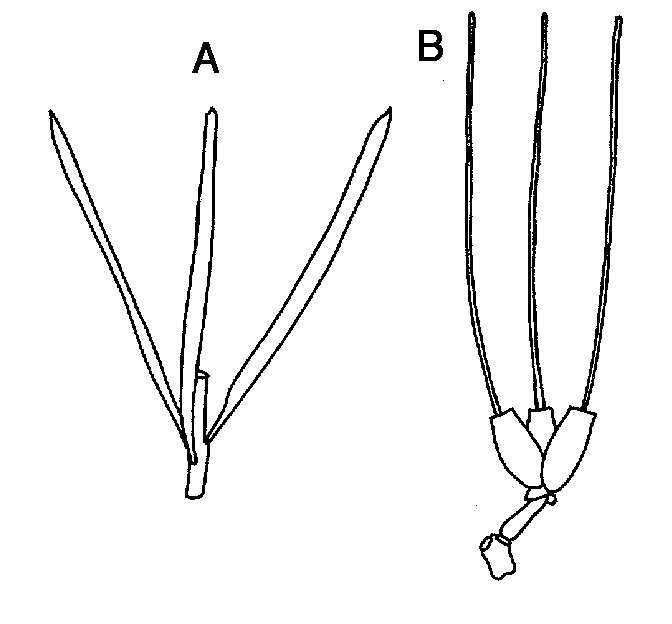
Distribution Map

Description (Barlow 1992)
Amyema canaliculata Barlow, Austral. J. Bot. 22 (1974) 569. - Type: Henty & Foreman NCF 42624 (holo LAE 112946; iso L), New Guinea, Sepik,Telefomin, Freida R., Prospect Ck, 600 m, on Dacrydium. 24.vi.1969.
For description see Barlow, Austral. J. Bot.
22 (1974) 569. Amyema canaliculata can be identified locally
by its combination of scattered-ternate, very narrow, strongly
channeled leaves without visible venation, inflorescence with
a short peduncle and few umbel rays, and flowers all sessile in
the triads. The flower colour is pink.
Amyema canaliculata is known only through the type specimen
from the Freida River area, Papua New Guinea (fig. 3), at an elevation
of 600 m. Habitat details are unknown other than the host record
on Dacrydium. It is a differentiate of the A. scandens
species complex which is well developed in New Guinea and
extends to New Caledonia. Within this complex it is distinct in
its leaf characters and unusual nondicotyledonous host. See discussion
under A. scandens.
Description (Barlow 1974)
Amyema canaliculatum Barlow, sp. nov.
Type. New Guinea, 600 m alt., West Sepik District, Telefomin Subdistrict, Prospect Creek (tributary of Frieda R.), Henty and Forernan NGF 42624, 24.vi.1969 (LAF 112946, holotype).
Glaber. Caules teres. Folia dispersa ternata;
lamina linearis-lanceolata., 7-13 cm longa, 0.3-0.6 cm lata, infra
convexa, supra valde concava, apice rotundata mucrone longo, basi
in petiolum obscurum teres c. 3 mm longum attenuata. Pedunculus
inflorescentiae c. 2 mm longus; radii 3, c. 4 mm
longi, fibres in triates omnes sessiles; bracteae patulae, triangulares,
c. 1 mm longae, marginebus in involucrum infra triadum
connatae. Calyx urceolatus, 4 mm longus; limbus erectus, truncatus,
1 mm longus. Corolla in alabastro maturo gracilissima, non clavata,
c. 24 mm longa.
Glabrous. Stems terete. Leaves scattered-ternate; petiole obscure,
terete, c. 3 mm long; lamina linear-lanceolate, 7-13 by
0.3-0.6 cm, thick, convex below and strongly concave above, attenuate
at the base, rounded at the apex but with a small mucro.
Inflorescences only seen detached; peduncle c. 2 mm long; rays 3, c. 4 mm long; triads with all flowers sessile; bracts spreading, triangular, c. 1 mm long, shortly united at the margins into an involucre below the triad. Calyx urceolate, 4 mm long; limb erect, truncate, 1 mm long. Corolla in the mature bud very slender, not clavate, c. 24 mm long. Open flowers and fruits not seen. (Fig. 5, d, e.)
Occurrence. Telefomin Subdistrict, Eastern New Guinea (Fig. 2), 600 m altitude.
Specimens Examined. EASTERN NEW GUINEA: West Sepik District, Telefomin Subdist., Prospect Creek, 600 m alt., Henty and Foreman NGF 42624, 24.vi.1969 (LAE).
Amyema canaliculatum is
a member of the Amyema scandens complex (see note under
A. scandens). The only known collection is quite distinct
in several characters. It differs from A. scandens in its
very narrow, strongly channelled leaves without visible venation,
in the very short peduncle and in the few-rayed umbel. The species
is also unusual (but not unique) in the family in parasitizing
a non-dicotyledonous host, as the recorded host is Dacrydium.
Illustrations

Amyema canaliculata. A - portion of plant. B - portion of inflorescence. From Barlow (1974).
Photographs
Amyema canaliculata
updated 18 January 2007